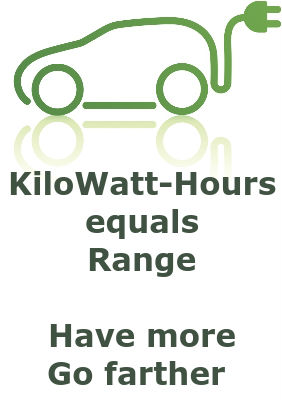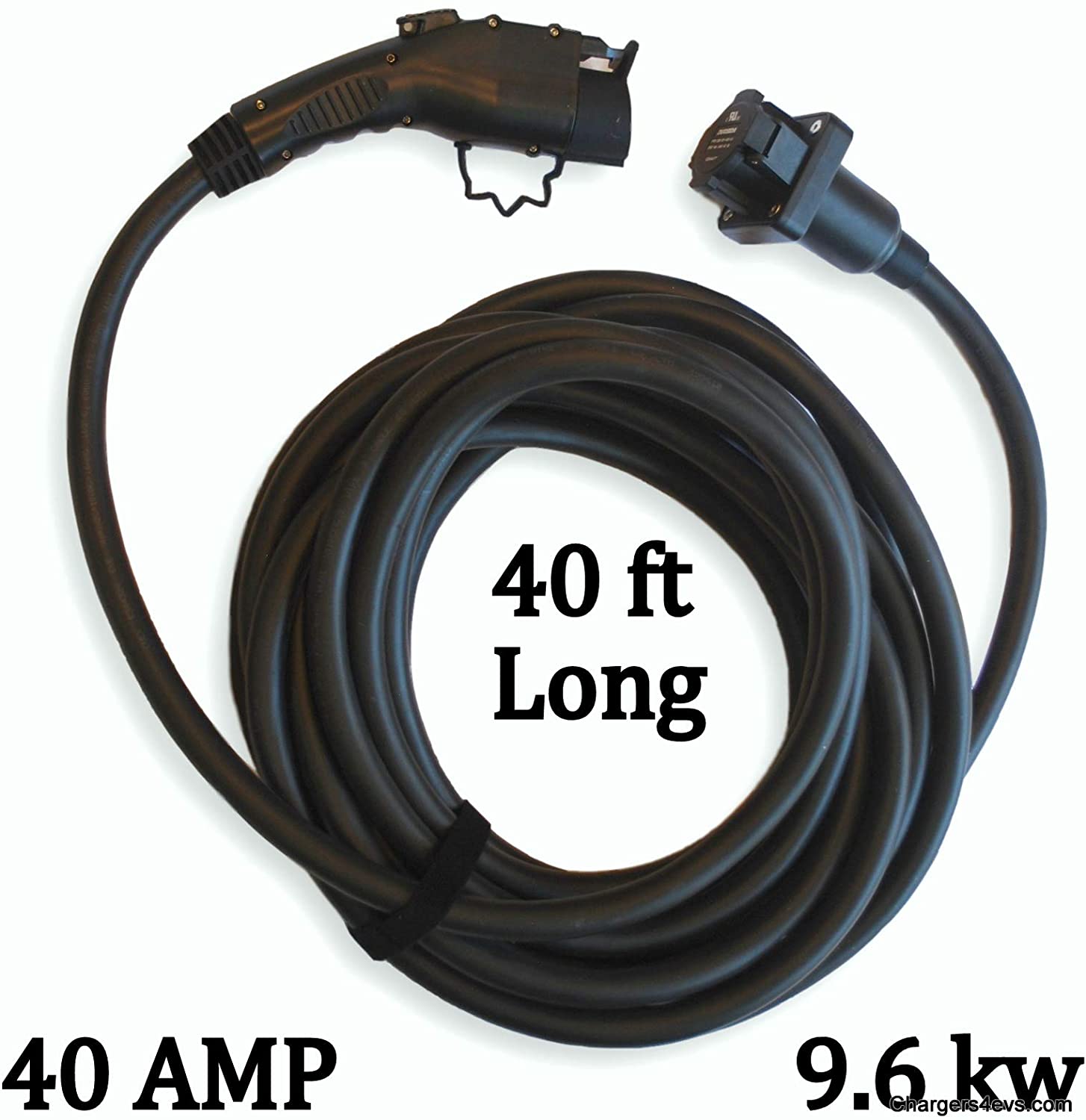Last Update: April 14, 2017

Until the 2017 model year, typical electric car models had a battery pack capacity of 24 kiloWatt-hours giving about 80 miles of range. Some had a bit more, others a bit less. Then there is Tesla Motors who started with a 60 kiloWatt-hour minimum, for about 200 miles range, and is now (April 2017), offering a 100 kiloWatt-hour model with 335 miles range. And the other automakers aren't sitting still. GM started selling the Chevy Bolt in December 2016, with an EPA-certified 238 mile range, Nissan is expected to start selling a longer-range Leaf this fall but details are unknown, and Tesla Motors is promising the Tesla Model 3 this fall. All have or are expected to have MSRP's at $35,000 and above.
But, what is a kiloWatt-hour? The prefix “kilo” means “thousand”, so a kiloWatt-hour is a thousand Watt-hours. By extension megaWatt-hours is a million Watt-hours, and gigaWatt-hours is a billion. The abbreviation is kWh. The 'W' is capitalized because the Watt is named after 1800's inventor James Watt.
A Watt-hour (Wh) is the amount of electricity consumed by a circuit using one Watt of power for one hour. A circuit consuming 10 Watts for 6 minutes, or 60 Watts for 1 minute, also consumes one Watt-hour of electricity. A 60 Watt incandescent bulb consumes 60 Watt-hours every hour, and requires 1000 minutes (16.6667 hours) to consume 1 kiloWatt-hour of electricity.
The 'W' is capitalized in honor of James Watt.
As an aside - the LED equivalent to a 60 Watt incandescent bulb runs at 9.5 Watts, requiring 105 hours to consume 1 kiloWatt-hour of electricity while producing the same amount of light. That's why LED lights are so interesting, because they achieve the same effect, while consuming a fraction of the electricity, and having an enormously long lifespan.
That’s nice, but what does that mean for a car? An electric car driving down the road consumes electricity. To understand these cars we need to understand electricity.
Here’s a few electric cars, some of which are from the previous EV era, and their electricity consumption and MPGe ratings (which we’ll discuss in a bit).
| Car model | Electricity per mile | Equivalent to Gasoline |
|---|---|---|
| 1997 GM EV1 (Lead Acid) | 164 Wh/mile | |
| 1999 GM EV1 (NiMH) | 179 Wh/mile | |
| 1996 Toyota RAV4 EV (Lead Acid) | 235 Wh/mile | |
| 2000 Toyota RAV4 EV (NiMH) | 400 Wh/mile | |
| 1998 Ford Ranger EV (Lead Acid) | 337 Wh/mile | |
| 1997 Chevy S10 EV (Lead Acid) | 292 Wh/mile | |
| 2014 BMW i3 BEV | 270 Wh/mile | 124 MPGe |
| 2014 Chevy Spark EV | 280 Wh/mile | 119 MPGe |
| 2014 Honda Fit EV | 290 Wh/mile | 118 MPGe |
| 2015 VW e-Golf | 290 Wh/mile | 116 MPGe |
| 2015 Nissan Leaf | 300 Wh/mile | 114 MPGe |
| 2015 Kia Soul EV | 320 Wh/mile | 105 MPGe |
| 2014 Ford Focus Electric | 320 Wh/mile | 105 MPGe |
| 2015 Tesla Model S 85D | 340 Wh/mile | 100 MPGe |
| 2014 Tesla Model S 60 | 350 Wh/mile | 95 MPGe |
| 2014 Tesla Model S 85 | 380 Wh/mile | 89 MPGe |
First thing I see in these numbers is that great aerodynamics on the GM EV1 enabled amazing energy efficiency ratings. The EV1 was such a beautiful car, it's a crime that GM crushed them. In any case, GM and Aerovironment worked together to give it excellent aerodynamics.
We go over this elsewhere, but a 24 kiloWatt-hour battery pack is roughly equivalent to 2/3rds of a gallon of gasoline equivalent, while delivering an 80 mile driving range. An 85 kWh pack is a tad over 2 gallons of gasoline equivalent, while delivering a 265 mile driving range. When we have that little energy on-board, we want to make the most use of it as we can, making aerodynamics extremely important.
How does a vehicle with 2/3rds of a gallon equivalent energy drive 80 miles? Electric motors are extremely efficient. Put another way, gasoline or diesel engines are extremely inefficient. All that heat they produce is pure waste, and a sign of bad engineering.
Among the current crop of EV’s, the BMW i3 is the efficiency king. BMW’s engineers didn’t win that crown through aerodynamics, but by light weight. BMW developed a method for mass producing carbon fiber, using it for major structures on the BMW i3 such as the whole passenger cabin. Carbon fiber has an extremely high strength to weight ratio, letting BMW build a lightweight car for high efficiency while improving structural rigidity in a way that should be extremely safe for the occupants. The point is that a lighter weight vehicle requires less energy to move.
At the other end of the scale is the Tesla Model S, which many complain is a “heavy” vehicle. That weight is readily apparent in the low efficiency ratings. Compare the 60 kWh and 85 kWh models, and the effect of a heavier car is obvious. That’s an additional 30 Wh/mile cost to move that extra weight. At the same time, with over twice the energy capacity of the typical affordable electric cars, the Model S 85 has a much longer electric driving range, about 265 miles, versus the 85ish mile range of the typical 24 kWh electric car. That extra range comes at a much higher cost, around $100,000 for the Model S.
For an attempt at perspective: At 300 Wh/mile (Nissan Leaf), that’s equivalent to burning five 60 watt light bulbs for an hour, to drive one mile.



